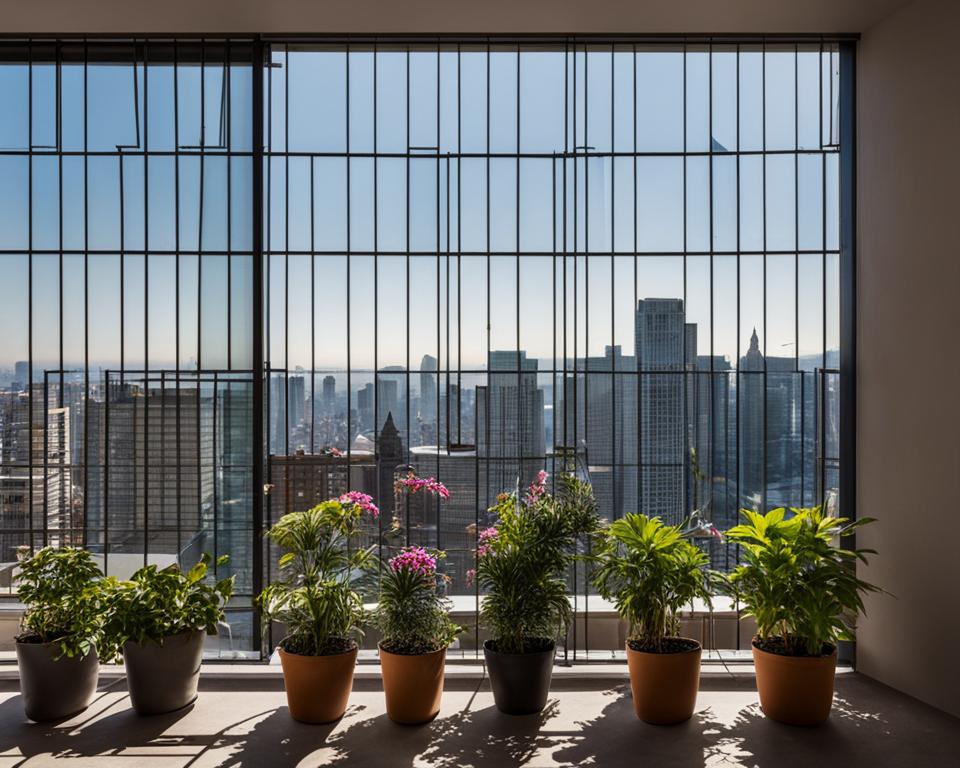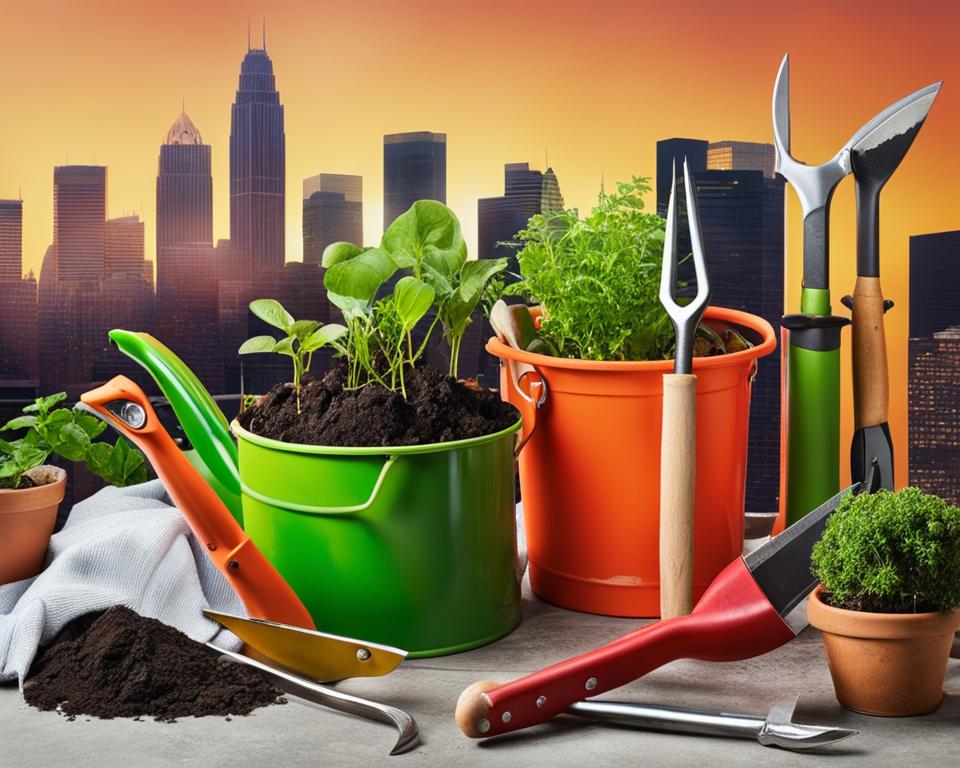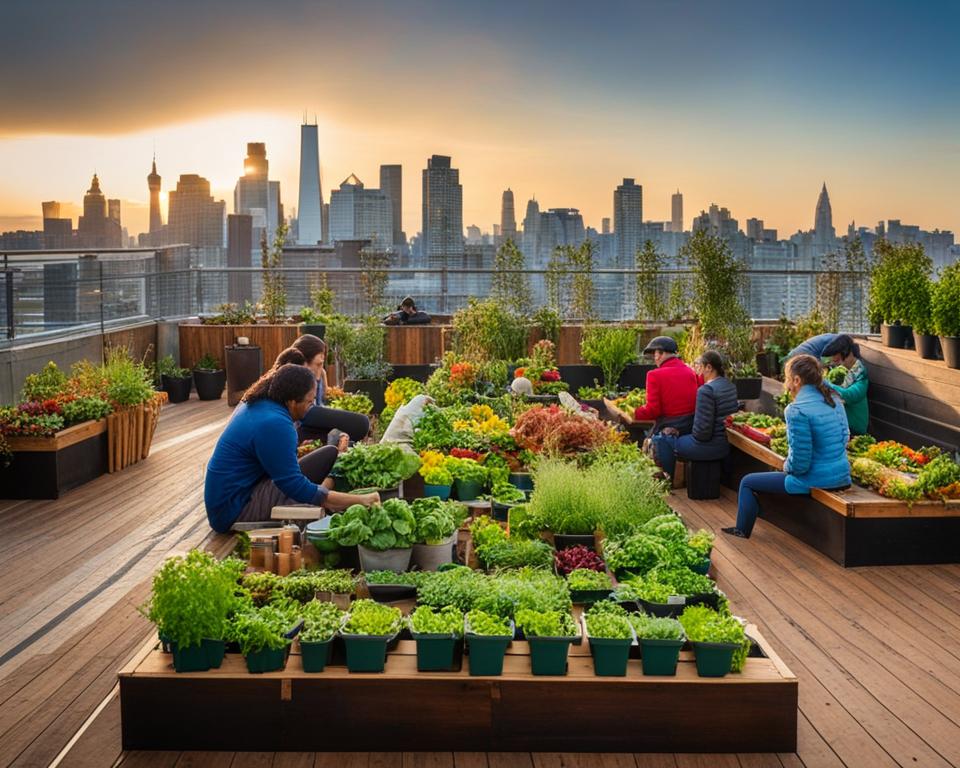Do you want to add some greenery to your urban space but don’t know where to start? Look no further than our comprehensive field guide to urban gardening. Whether you have a small balcony, rooftop, or even just a windowsill, you can transform any urban environment into a lush green oasis with the help of our tips, techniques, and ideas.
Our guide is tailored specifically for urban gardeners of all levels, from beginners to experts. Discover the numerous benefits of urban gardening and learn about essential techniques that will help you maximize space and optimize plant growth in urban environments. We’ll also provide you with a list of valuable resources to expand your knowledge and connect with fellow urban gardeners.
Key Takeaways:
- Urban gardening is accessible to anyone, regardless of the size of your space or level of experience.
- Our field guide provides tips, techniques, and ideas to help you create a thriving greenPatch anywhere you desire.
- Urban gardening has numerous benefits, including improving air quality and reducing stress.
- Essential techniques for urban gardening include container gardening, vertical gardening, and hydroponics.
- Find all the necessary tools and supplies for urban gardening by exploring local stores and online retailers.
Why Urban Gardening?
Urban gardening has become a popular activity for city dwellers, and for good reason. There are numerous benefits to urban gardening, both in terms of physical and mental well-being. Here are just a few of the benefits:
- Improves air quality: Plants naturally filter pollutants from the air, helping to improve air quality in urban areas.
- Reduces stress: Gardening has been shown to reduce stress levels and promote relaxation.
- Provides fresh produce: By growing your own fruits, vegetables, and herbs, you can have access to fresh, healthy produce right at home.
- Increases physical activity: Gardening is a great way to get some exercise and stay active.
- Connects you with nature: Urban gardening allows you to connect with nature, even in the heart of the city.
These are just a few of the many benefits of urban gardening. By taking up this activity, you can improve your health, reduce your environmental impact, and enjoy the beauty of nature right in your own backyard, balcony, or windowsill.
Getting Started with Urban Gardening
Are you new to urban gardening? Don’t worry; we’ve got you covered. Follow these steps to get started:
- Assess your space: Take a look around your urban area and find a suitable spot for your garden, such as a balcony, rooftop, or windowsill. Consider how much sunlight the area gets and whether or not it is shielded from the wind.
- Select your plants: Choose plants that are suitable for your space and your level of expertise. If you’re a beginner, start with easy-to-grow plants like herbs, lettuce, or cherry tomatoes. Make sure to consider the amount of sunlight and water your plants will need.
- Prepare your space: Clean your chosen space, remove any debris, and make sure the area is flat and level. If you’re using pots or containers, fill them with the appropriate soil and add some organic fertilizer.
- Plant your garden: Carefully plant your chosen plants in the appropriate containers, ensuring they have enough space to grow. Water them well and add some mulch to help retain moisture and prevent weeds.
- Care for your garden: Regularly water your plants and fertilize them as needed. Monitor them for any signs of pests or disease and take action immediately if necessary.
Remember, urban gardening is all about trial and error. Don’t get discouraged if your first attempts aren’t successful. Keep learning from your mistakes and enjoy the process of watching your garden thrive.
Tools for Urban Gardening
Here are some essential tools for urban gardening:
| Tool | Function |
|---|---|
| Hand trowel | Used for digging small holes and transplanting seedlings |
| Pruning shears | Used for trimming and shaping plants |
| Watering can | Used for watering plants without making a mess |
| Portable grow light | Used for providing additional light to plants in low-light areas |
Having these tools on hand will make your gardening experience easier and more efficient.
“Urban gardening is all about trial and error. Don’t get discouraged if your first attempts aren’t successful. Keep learning from your mistakes and enjoy the process of watching your garden thrive.”
Essential Techniques for Urban Gardening
Urban gardening requires specific techniques to overcome the challenges of limited space and less natural light. In this section, we’ll explore some essential urban gardening techniques to help you maximize your garden’s growth potential.
1. Container Gardening
One of the most popular urban gardening techniques is container gardening. This technique involves growing plants in pots or other containers, allowing you to plant in any available space. Containers come in various sizes and materials, including plastic, ceramic, and terracotta. Choose a container that suits the size and type of plant you want to grow and has proper drainage holes to prevent root rot.
2. Vertical Gardening
Vertical gardening is an innovative way to maximize space in your urban garden. This technique involves growing plants on vertical surfaces, such as walls, using trellises, hanging baskets, or shelves. Not only does vertical gardening utilize less horizontal space, but it also creates a visually appealing garden that can accentuate the beauty of your home’s exterior walls.
3. Hydroponics
Hydroponics is an indoor gardening technique that doesn’t require soil. Instead, it uses nutrient-rich water to grow plants. This technique is ideal for small spaces, as it uses less water and can produce more plants than traditional soil gardening. Hydroponics systems come in various sizes, from tabletop to commercial, allowing you to choose the system that best fits your needs and space.
4. Companion Planting
Companion planting is a technique that involves growing different plants together to ensure they thrive. Certain plants have natural pest-repelling or nutrient-enhancing properties that can benefit neighboring plants. For example, planting marigolds next to tomatoes can deter pests, while planting beans next to corn can provide the corn with nitrogen-rich soil.
By employing these essential urban gardening techniques, you can make the most of your limited space and create a thriving garden in any urban environment.
Creative Ideas for Urban Gardening

Urban gardening isn’t just about growing plants in pots or containers. There’s a world of creative possibilities to turn any small space into a green oasis. Here are some urban gardening ideas to get you inspired:
Create a Living Wall
Living walls are a beautiful way to add greenery to your urban space. They’re vertical gardens that can be attached to walls or structures, inside or outside. They not only look stunning but also help purify the air, reduce noise pollution, and insulate buildings. You can create a living wall using a variety of plants such as succulents, ferns, and herbs.
Grow Herbs and Vegetables
If you have a small balcony or windowsill, try growing fresh herbs and vegetables. They not only add color and texture to your space but also provide you with fresh and healthy produce. You can grow herbs such as basil, mint, and parsley in small pots or hanging baskets. Vegetables, such as cherry tomatoes, cucumbers, and peppers, can be grown in larger containers or raised beds.
Make a Fairy Garden
If you’re looking for a fun and whimsical way to add some charm to your urban space, consider making a fairy garden. These miniature gardens are designed to attract fairies and other magical creatures. You can use small plants, rocks, and fairy figurines to create your garden. They’re great for kids and adults alike and add a touch of fantasy to your urban environment.
Hang a Vertical Garden
If you’re short on space, consider hanging a vertical garden. These are gardens that are grown vertically using hanging planters or trellises. You can grow a variety of plants, such as flowers, succulents, and vegetables, in a vertical garden. They’re a great way to maximize space and add a unique touch to your urban space.
Reuse and Upcycle
When it comes to urban gardening, the possibilities are endless when it comes to reusing and upcycling items. You can turn old furniture, such as dressers or shelves, into planters. You can use old buckets or cans as pots. You can even use old pallets to create a raised garden bed. Get creative and eco-conscious!
Resources for Urban Gardeners
If you’re looking to expand your knowledge and connect with other urban gardeners, there are many valuable resources available to you:
- Online Communities and Forums: Join online groups such as Reddit’s urban gardening community, Facebook groups, and gardening forums to connect with fellow gardeners, ask for advice, and share your experiences.
- Books: There are many books available on urban gardening, ranging from beginner guides to advanced techniques. Check out “The Urban Gardener” by Matt James or “Vertical Gardening” by Derek Fell for inspiration.
- Websites: Websites like Urban Farmer and the National Gardening Association offer a wealth of information on urban gardening, including plant care guides, how-to articles, and product recommendations.
- Local Gardening Centers: Visit your local gardening center for expert advice, high-quality supplies, and workshops on urban gardening.
With these resources at your fingertips, you’ll have all the tools you need to succeed in your urban gardening journey.
Must-Have Tools for Urban Gardening

Urban gardening requires a specialized set of tools to help you achieve the best results in a limited space. Whether you’re a beginner or a seasoned gardener, having the right tools can make a significant difference in ensuring your plants thrive. Here are some must-have tools for urban gardening:
| Tool | Description |
|---|---|
| Hand Trowel | A small handheld tool used for digging, planting, and weeding in tight spaces. |
| Pruning Shears | Used for trimming and shaping plants. |
| Watering Can | An essential tool for watering plants in small spaces. Choose a compact size that fits your needs. |
| Portable Grow Lights | Grow lights are essential for indoor gardening. Choose a portable option that allows you to move the lights as needed and change the light intensity depending on your plants’ needs. |
| Garden Scissors | Used for pruning, trimming, and deadheading plants. |
| Multifunctional Water Hose Nozzle | This adjustable nozzle easily switches between different spray patterns for watering plants, washing surfaces, or misting seedlings. |
| Gardening Gloves | Protect your hands from thorns, prickly plants, and blisters while gardening. |
| Soil Test Kit | Check your soil’s pH level, nutrient content, and moisture level to ensure optimal plant growth and health. |
These tools can help make your urban gardening experience more enjoyable and successful. Don’t hesitate to invest in high-quality tools that will last for years and make a real difference in your garden.
Where to Find Urban Gardening Supplies
Ready to start your urban garden? Before you get your hands dirty, you’ll need to stock up on supplies. Here are some of the best places to find everything you need to grow healthy and vibrant plants in your urban space:
| Retailer | Products | Website |
|---|---|---|
| The Home Depot | Soil, planters, seeds, fertilizers, tools | www.homedepot.com/c/gardening |
| Lowe’s | Soil, planters, seeds, fertilizers, tools | www.lowes.com/c/Gardening-plants-outdoor-living |
| Amazon | Planters, seeds, fertilizers, tools | www.amazon.com/Gardening-Lawn-Care |
| Wayfair | Planters, tools, outdoor decor | www.wayfair.com/outdoor |
In addition to these retailers, your local garden center or nursery may have a selection of urban gardening supplies. Don’t be afraid to ask for advice or recommendations from the staff, as they are often passionate and knowledgeable about gardening.
Remember to check for sales and discounts, especially during peak gardening seasons in the spring and summer. You can also save money by repurposing items for your garden, such as using old milk jugs as planters or turning a wooden pallet into a vertical garden.
With these resources, you’re ready to make your urban garden a reality. Happy planting!
Conclusion
Urban gardening is an excellent way to bring nature into your daily routine and create a relaxing green space in your urban environment. We hope that this field guide to urban gardening has provided you with the necessary knowledge and resources to start and maintain a thriving garden no matter where you live. With the right tools, techniques, and ideas, you can turn any small urban space into a lush green oasis.
Remember that urban gardening has numerous benefits, from improving air quality and reducing stress to growing your own fresh produce. So, what are you waiting for? Start your urban gardening journey today and enjoy the beauty and benefits of having your greenPatch.
Thank you for reading this field guide to urban gardening. We wish you all the best on your gardening journey!
FAQ
What is urban gardening?
Urban gardening refers to the practice of growing plants and vegetables in an urban environment, such as on balconies, rooftops, or windowsills. It allows city-dwellers to create green spaces and cultivate their own food, even in limited spaces.
Do I need any prior gardening experience to start urban gardening?
No, you don’t need any prior gardening experience to start urban gardening. Our field guide provides step-by-step instructions and tips for beginners to help them get started and succeed in urban gardening.
What are the benefits of urban gardening?
Urban gardening has numerous benefits. It improves air quality, reduces stress, and enhances mental well-being. Additionally, it allows you to have access to fresh and nutritious produce, promotes sustainability, and creates a sense of community.
Can I grow plants and vegetables in small spaces?
Yes, you can grow plants and vegetables in small spaces. Urban gardening techniques like container gardening and vertical gardening allow you to maximize space and grow a variety of plants even in tight urban environments.
Where can I find resources to learn more about urban gardening?
There are various resources available to expand your knowledge of urban gardening. You can find online communities, forums, books, websites, and local gardening centers that provide valuable information and support for urban gardeners.
What tools do I need for urban gardening?
Some essential tools for urban gardening include hand trowels, pruning shears, compact watering systems, and portable grow lights. These tools will help you effectively care for your plants and optimize their growth in urban spaces.
Where can I buy urban gardening supplies?
You can find urban gardening supplies at various places. Online retailers and local stores offer a wide range of supplies such as organic soil, planters, seeds, and fertilizers. Check out our recommendations for the best places to find all the necessary supplies for your urban garden.

